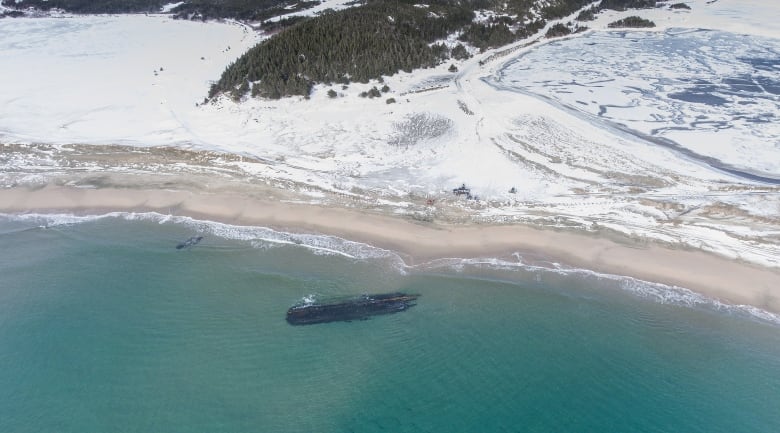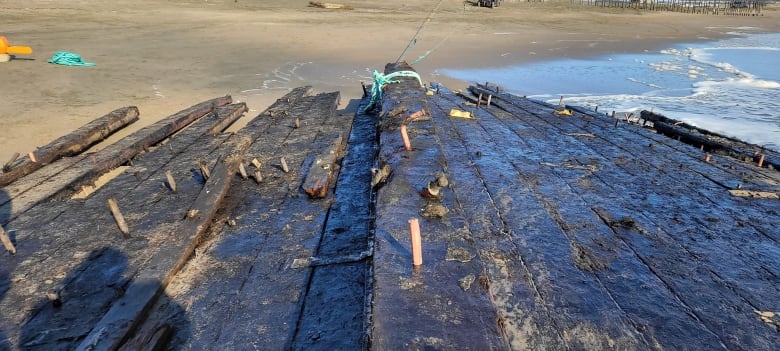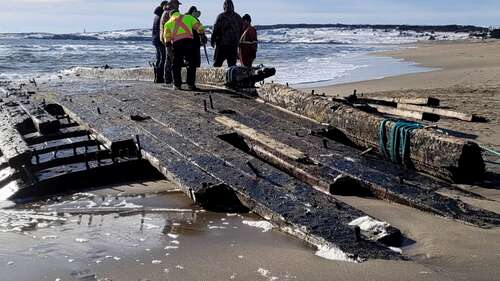
The shipwreck that unexpectedly appeared along Newfoundland’s southwestern tip in late January has captured the imagination of people across the globe, especially residents who live near the site, who are now scrambling to preserve the remnants of the ancient vessel.
Preserving the overturned hull in a museum would be costly given how large it is — perhaps hundreds of thousands, if not millions of dollars, says the Shipwreck Preservation Society of Newfoundland and Labrador.
But there are ways to keep the historic ship in the community for a few more decades; it’ll just require thorough documentation and a lot of salt water, said James Delgado, the former director of maritime heritage for the National Oceanic and Atmospheric Administration.
“Document as best you can, save what you can,” said Delgado. “And with that perhaps … give people a sense, walking on a beach outside of a surfline, that here is a ghost from the past unearthed from its grave that perhaps has a story to tell.”
Preserving a ghost from the sand
Delgado said there are a few approaches to preserving shipwrecks that aren’t able to make it into a museum. One is to tag the ship, note where it is in the water, and let it drift naturally.
The other is to bring the structure high above the surfline so passersby can get a glimpse of the past, said Delgado.
The race to preserve a washed-up shipwreck in Cape Ray is still on. Folks have secured the wreck on the beach, and it’s mostly out of the water. Neil Burgess of the N.L. Shipwreck Preservation Society gives us his take on what could happen next.
It’s a process local residents and divers are working diligently to achieve, said Neil Burgess, the president of the Shipwreck Preservation Society. Community members have launched an online fundraiser to raise money that would allow them to recover, transport and preserve what they are calling a “unique piece of history.”
Burgess said the ship has been pummeled in the surf, and as the waves continue to hit the wreck, pieces of the hull are becoming loose and could eventually tear parts of the structure apart. A bulldozer or excavator would need to pull the hull out, he said, which has become heavy with water. The longer that takes, the less of the ship there will potentially be to pull out, he said.
“It’s kind of a race against time at this point,” he said.
If residents are able to bring the ship away from the surfline, the next step to preserving it is to keep it wet with salt water, a piece of the process Delgado says is “absolutely critical.”
If the vessel has been buried for over a century and a half, which Delgado says is likely, it’ll be saturated with water, and the wood’s composition will have changed from such a long soak. Once it dries, the wood will splinter, with the extent of the splintering dependent on the materials used in the ship.

Delgado said people should throw buckets of water on the ship every day to keep it from drying out. The ship also shouldn’t be brought indoors if it’s not going to be preserved at a museum standard, because once it’s out of the humidity and the moisture of salt air, the ship will dry and break apart.
“We’ve often left these in place on beaches all over the world because this phenomena, particularly as climate change is here and as beaches are now getting hit with heavy erosion, more and more of these ghosts from the past are emerging from the sand,” he said.
Delgado says it’s hard to tell how long the structure will last if it’s kept wet on the shore, but it’s entirely possible that if it’s out of the way of the surfline, it could last for a few decades, he said.
“Let’s be clear: inevitably all things go and break apart,” said Delgado. So the best thing people can do is keep the ship intact as best they can, touch it, take samples and continue to try to learn more about its makeup and origins.
That’s why, says Delgado, another crucial step is for residents to document the ship — take photographs, measure its parts, get a detailed drawing of the ship to scale, and mark the wooden trunnels, pins that fasten the wood together.

Delgado says people have also begun to virtually preserve ships using cameras or lidar, a way to measure ranges using lasers.
Provincial archaeologist Jamie Brake told CBC News he and other experts have collected a number of samples, including copper rods, wood and mortar to learn more about the ship, including its age and origin.
Myth of uniqueness
Brake told reporters that experts don’t have enough information to indicate whether the ship is a unique specimen, and without an in-depth analysis of the samples from the vessel, Burgess says it’s too early to sign off on its significance or a lack thereof.
Thousands of ships, likely similar to the one in Cape Ray, were built in the 19th century, said Delgado, as tradeways became global, connecting places such as Newfoundland and Labrador to the rest of the world. Ships were likely as common as freight trucks are today, he said.
But that doesn’t take away from a shipwreck’s novelty.
“I think too many times we get hung up on the concept of uniqueness or originality,” said Delgado.
What makes ships important is what they meant to families and communities, he said, and the way they shaped towns and environments. More needs to be gleaned from the ship’s samples through archaeological study, and hopefully, the community of Cape Ray will be able keep the ship on the shore for people to look at and learn from for years to come.
“The importance would not be that it’s unique, but that it speaks to something now gone that was once so common,” he said.
“It’s not the famous people, it’s not the ones whose names show up in the history books. What makes history is the rest of us who get up and go to work every day and in a case of something like this, those who got up to go to work and had to go to sea, knowing that there was no guarantee, perhaps, that they’d be able to come back.”
Download our free CBC News app to sign up for push alerts for CBC Newfoundland and Labrador. Click here to visit our landing page.




